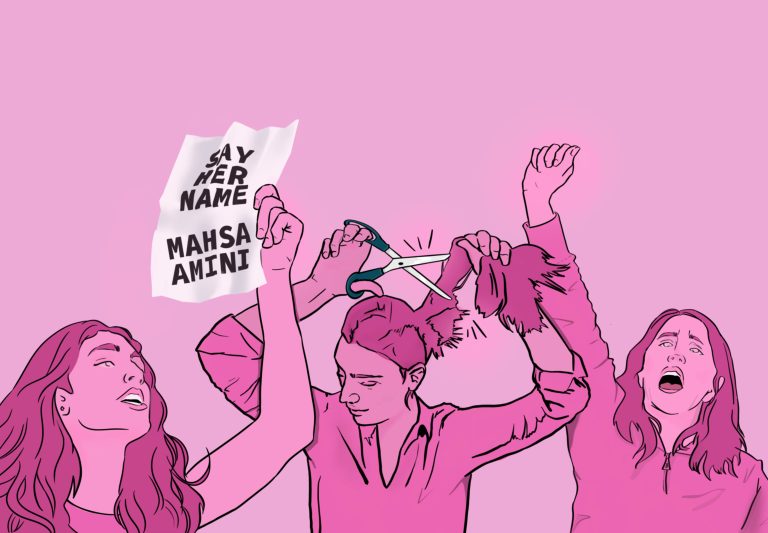The Human Rights Crisis in Iran
The civil unrest engulfing Iran has sparked protests, with demonstrators calling for greater freedom for women and an end to theocratic rule. Graphic by Lucia Derriman ’24.
Mahsa Amini, a 22-year-old Iranian woman, has posthumously made the 2022 Forbes list of the World’s 100 Most Powerful Women, according to Forbes. On September 13, 2022, Mahsa Amini was arrested in Tehran, Iran for a dress-code violation, specifically, official claims that Amini had failed to cover her hair with a hijab and was wearing pants that were deemed to be too tight. While in custody, Amini suffered a cardiac arrest and lost consciousness and died after three days. The Iranian police maintain that Amini passed away due to a pre-existing medical condition, despite photos of her visible bruises and persistent claims from her family that Amini had been perfectly healthy.
Before the Iranian Revolution of 1978, the country was ruled by a Shah who promoted westernization and was heavily supported by the United States. Economic disparity between most Iranians and the Shah led to widespread discontent and revolution. An authoritarian Islamic Republic was established. Over its 40-year rule, the current government has not tolerated dissenting political parties. Restrictive, discriminative policies that require women to dress a certain way are now causing controversy worldwide, as women demand free will after decades of oppression.
The civil unrest engulfing Iran has sparked protests, with demonstrators calling for greater freedom for women and an end to theocratic rule.
There has been mounting support across the Middle East, the U.S., Europe and Asia.
“What distinguishes the present struggle for civil liberties and democracy in Iran is the nature of its driving force,” said M. Rahim Shayegan, UCLA’s Amuzegar director of the UCLA Pourdavoud Center for the Study of the Iranian World in a statement released by the university. “It is led by young, educated women of all ethnic and social backgrounds, united in their desire to live in dignity and happiness within an equitable and free society,” Shayegan said.
Amini’s death sparked intense and passionate protests across Iran from those continuing to oppose Iran’s “morality police”. Women are leading anti-hijab protests across the country and the world, with many electing to forego the required hijabs in a pointed demonstration against the Iranian regime. While the death of Amini undoubtedly led to this action, women are protesting decades of ill treatment. The world has watched as women across the globe stand in solidarity with the Iranian women who have been stripped of their human rights. Many are demonstrating this with specific actions such as those who are cutting their hair in protest, including multiple public figures and actresses.
In a unique act of protest, Iranian singer Shervin Hajipour composed a song consisting of tweets from protestors, which has gone viral. The song, “Baraye,” has become an anthem for Iranian protestors everywhere as they are continuing to take to the streets, calling for an end to the so-called long-standing, exclusionary and misogynistic dictatorship.
Protests have been met with a violent response from the Iranian government, including several beatings and arrests. Nika Shakarami, a sixteen year old Iranian girl, was murdered during one of the many protests in an attack that killed sixty-six people. Shakarami’s death is especially present in the current news cycle because of how it was hidden by the government for nine days as they attempted to make her death appear to be an accident. She presented one of the greatest threats to the Iranian regime in years, and has recently become an icon of the protests.
Another woman punished for speaking out is Niloofar Hamedi, an Iranian journalist. Hamedi was arrested and placed in solitary confinement for releasing a moving photo of Mahsa Amini’s parents embracing in the hospital. After the eighth week of protests in Iran, the country’s parliament ordered the first known death sentence for protests.
Iran continues to sentence various protestors to death for unclear national security crimes, despite outcry from protestors around the globe. Protestors are demanding democracy and freedom and begging for an end to executions.
Read more about personal choice from the perspective of a Mayfield student here.

Alisa Balian is a senior at Mayfield Senior School. She has been a part of the Mayfield Crier since her sophomore year, and this year she is the Co-Editor-In...


